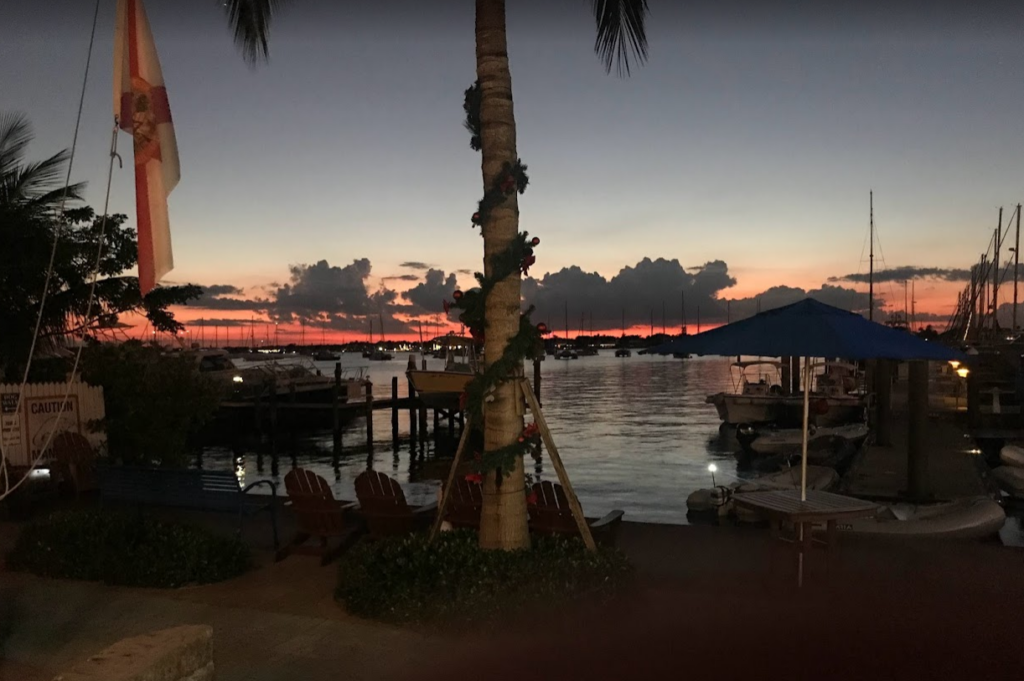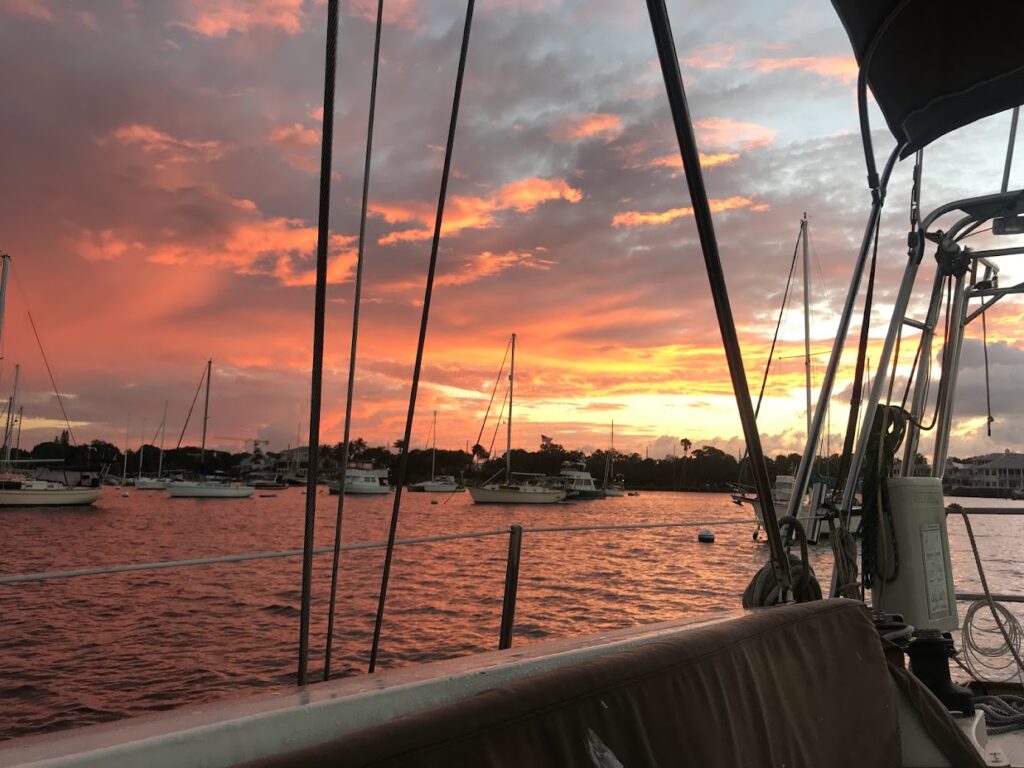27°12’03.3″N 80°15’34.7″W
Mid December, 2021
In mid December, approximately 6 weeks after leaving Strider, I traveled back to Florida to check on her. A local friend had done a few checks in the interim (thanks John!), but I needed to start the process of figuring out and fixing the electrical issues. Plus, any excuse to get to Florida in the winter is a good one…
As you can see, Christmas season evenings in Florida are tough!

Mornings are even tougher!

Electrifying!
There were a number of electrical issues that came to light on that maiden voyage.
- The engine was having trouble charging the batteries and it didn’t have a bank isolator.
- The solar panel wasn’t charging the batteries.
- The wind generator wasn’t charging the batteries.
- I had no generator that I could use for AC and battery charging.
So once the batteries went dead on my trip, I had no good way of getting them back up.
My main goal on this trip was to figure out a sustainable way to keep the batteries charged. I’d charged the batteries at the marina while on shore power, but John had reported the voltage to me and they were slowly dropping.
Solar
When I left in November, the one solar panel I had didn’t seem to be doing anything. One of the first things I did was to begin checking over that system. I’d put it in place very quickly before leaving in November so I assumed the problem was likely my doing. However, checking over things, it seems the brand new charge controller was non-functional.
Solar panels in full sunlight produce significantly higher voltage (around 20 volts) than what is proper charging voltage for a 12-volt battery. The batteries charge a few tenths of a volt higher than their current voltage, up to a maximum of about 14 volts. The charge controller’s job is to take that fluctuating input voltage from the panels and convert it to a clean, proper voltage for the battery bank. However, my charge controller wasn’t giving any power at all. Maybe that explains why the batteries weren’t charging!
Fortunately, I had another new, better quality charge controller. I hooked it up, improved the wiring situation as well, and repositioned the panel to be better in the sunlight and voila! my batteries suddenly began to charge. It wasn’t fast, but the direction was the correct one! With the concept proven and the wiring in place, I should be able to go from a single, small panel up to much more solar regenerative capacity in the future.
Wind
I have an old wind generator on the boat but the previous owner wasn’t able to tell me if it worked or not. The blades had been tied up so they couldn’t spin and it was something I never got around to testing. It worked or didn’t and either way wasn’t going to change whether I purchased Strider or not.

However, while stuck without power I’d untied the blades and begun testing. Unfortunately I couldn’t seem to get more than a couple volts out of it, in the range of 2-4. This isn’t enough to do anything so I assume the wiring or the wind generator is cooked somewhere. I tied the blades back up and left it for another day.
Generator
While in Florida I picked up a little “silent” generator to use in place of shore power while I’m away from the dock. I was able to hook it right in where shore power plugs in and have full AC power.
One thing I did learn though, a “silent” generator in the woods isn’t a silent generator on the water. It felt much louder than I’m sure it would 100′ from a tent in the middle of the woods. In that context one would hardly hear it. However, sitting on deck it was quite audible. I ran it a few hours one evening just to get some bulk charge into the battery bank, but in deference to my neighbors in the marina, didn’t run it too long.
Again, the process was proven and worked so this option was added to the backup systems. Progress! This was a small, gas powered generator with a maximum running wattage of about 1,800 watts (13 amps). To run everything Strider wants closer to 30 amps, but that includes air conditioning which I’m unlikely to NEED. The proper way to have a generator on a boat is to buy a marine generator that installs into the engine room, runs off the house diesel and is water cooled, just like the inboard engine. This would be a wonderful solution, however, a 8kw marine generator is about $10k, so… that ain’t happening!
Engine power
The final chore was to install and test the battery isolator between the engine battery and the house battery banks. This is important so that the engine can charge all banks, but draining the house batteries doesn’t also drain the engine starting battery and leave one stranded.

The way it works is it monitors the voltage on the start battery side and isolates the banks if the voltage is below a certain level. Once the alternator has fully charged the start battery, the isolator opens the path to the second bank (house batteries in my case) to allow them to start charging.
Monday morning, my last day on Strider I washed laundry and ran some other errands, and then hooked up the isolator. It clicked over to the start battery just as it should. I finished hooking up the house batteries. Now, as my last task before leaving for the airport, I wanted to run the engine for a half-hour or so to exercise it and to make sure charging was working.
Disaster
This next and final section for this trip is hard to write. I hadn’t run this brand new engine since November 3rd. It had, for the most part, worked flawlessly on the trip up from Miami other than tripping the breaker which was likely my fault.
Today, to exercise it and charge the batteries I wanted to run it for a few minutes. Of course, before attempting to start it I pulled the dipstick to check the oil…
Sea water FOUNTAINED out of the oil dipstick hole! This brand new engine had somehow, inexplicably, filled with sea water in the intervening 6 weeks. I quickly plugged the dipstick back in to prevent the water from draining out and to keep oil out of the bilge (and the bay).
At that point I just closed up the engine room and left. There was nothing I could do. I didn’t yet understand why or how it happened and I had a plane to catch.
The next day back up north, I emailed the Yanmar service rep and then had a long phone conversation with him to begin the process of understanding how this happened and how big a deal it was. The news wasn’t good. The engine is very likely ruined. According to him, the only way to know if it is ruined is to drop the oil pan and do a full inspection which means pulling it back out of the boat, essentially completely redoing the work done over the last 6 months at huge cost.
As to how it happened, frankly the installer didn’t put it in correctly. There is at least one problem, probably two. Firstly, there should be an anti-siphon loop on the exhaust. This was nowhere to be found. Secondly, there is a good chance the sea strainer, a filter on the raw water coming into the engine, is installed too low. This allows sea water to slowly seep into the engine even when it isn’t running. When it was being run every day or frequently this didn’t manifest as a problem. But over several weeks, the water slowly filled the exhaust and then began seeping into the engine, gradually filling it.
I notified the installer of the problem that same day, December 14th. Time is of the essence if there is any hope of salvaging the engine. However, as something they need to remedy, they need to drive the process. He called me to talk about the problem and I gave him the names and numbers of local, highly recommended boat mechanics. He told me he’d try to get a mechanic on Strider to begin to assess. Since then I haven’t heard anything. I guess we will see what the new year brings. As of the writing of this blog on New Year’s Day, 2022, the installer has done nothing.
